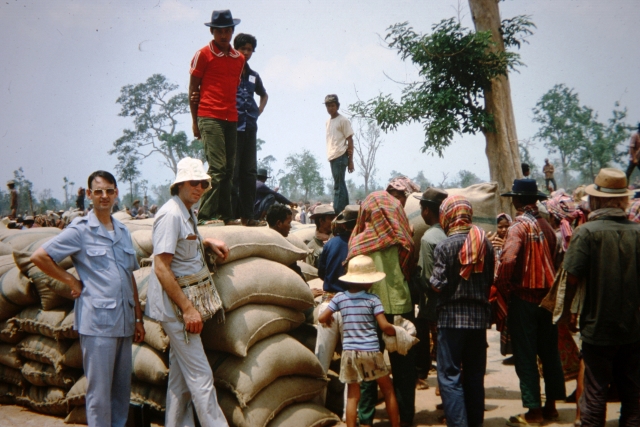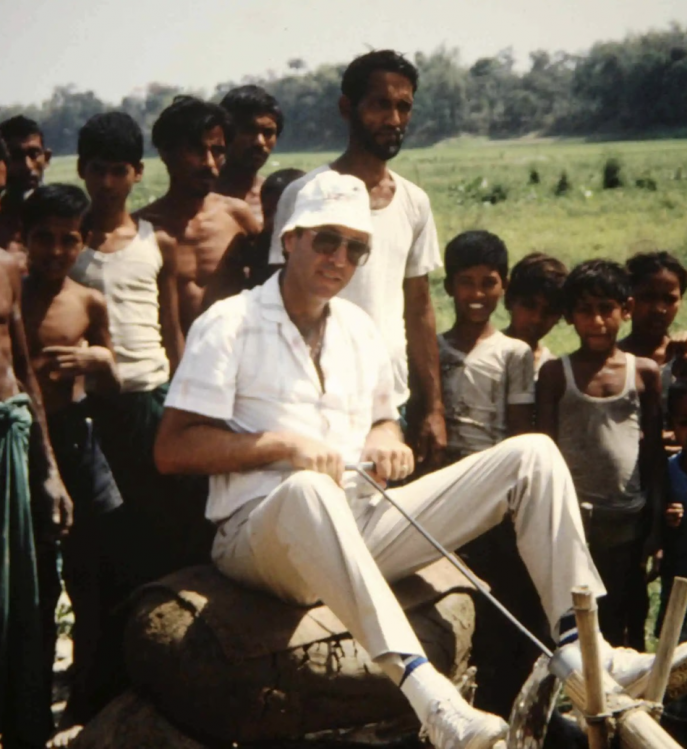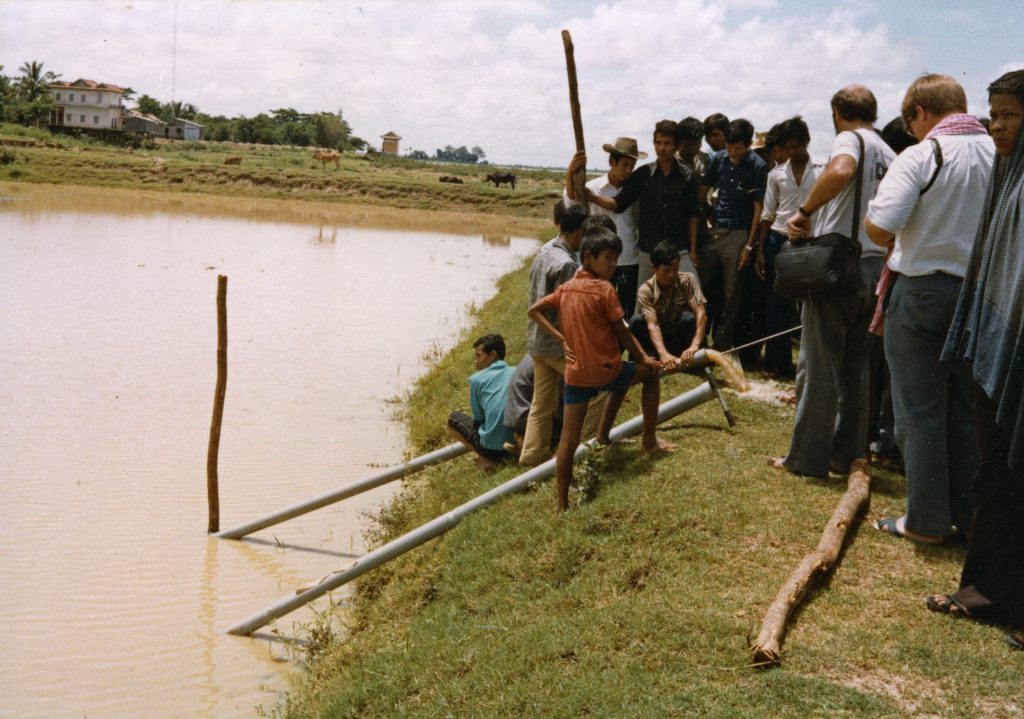One of MCC Bangladesh’s national staff, Arefur Rahaman, shared this article from The Business Standard newspaper out of Dhaka about Art DeFehr and the early work of MCC Bangladesh. I’d heard many people talk about Art DeFehr before but this was the first time that I’d seen his work in Bangladesh outlined so comprehensively in writing. I think there’s a lot to learn and be inspired by here.
I should also note that MCC Bangladesh also had a major impact on agriculture in Cambodia. In the immediate aftermath of the Khmer Rouge, MCC Bangladesh sent hundreds of thousands of vegetable seed packets to Cambodia which introduced many winter vegetables noted in the article here as well.

In 1972, very few people would have predicted Bangladesh would become the ‘economic miracle’ it became in just five decades of its birth. The country had been ravaged by a ninth-month liberation war, ten million people had been displaced, infrastructure had all but collapsed and there was widespread hunger and homelessness.
Eighty percent of Bangladesh’s population lived below the poverty line and nearly all of the country’s GDP was coming from agriculture. Even there, rice and jute were the only two crops being produced.
Henry Kissinger had infamously described the new country a ‘bottomless basket’.
That same bottomless basket entered its sixth decade in 2022 enjoying an economic growth of six to seven percent in the decade leading up to it. Its per capita GDP has gone past both Pakistan and India, it has achieved food security and is the second largest exporter of readymade garments in the world.
Numerous governments have all played a role in achieving this success, as did the non-government sector. But in those early years, there were a number of individuals and organisations who worked tirelessly to ensure the country did not sink into bottomless misery, in the process planting the seeds for much of the success the country achieved later.
One such individual whose role has largely remained in the shadows was Arthur A. DeFehr, one of the founders of iDE, then the country head of Mennonite Central Committee, US, a development organisation with global presence.
DeFehr had arrived in Bangladesh just six months after the country became independent with a mandate to – in his own words – ‘do something in agriculture’. Over the next two years, DeFehr planted the seeds of Bangladesh’s transition from a rice and jute producing country to achieving nutritional self-sufficiency, inculcating among farmers and policymakers the need to grow a variety of crops to meet the nutritional needs of a severely malnourished population.
Under his leadership, MCC Bangladesh introduced soybean and various winter vegetables such as cauliflower, cabbage, carrots, oilseeds (e.g. sunflowers), and improved potato varieties in Bangladesh to address nutrition deficiencies.
He went above and beyond his mandate to bring together the resources to materialise his vision, collaborated innovatively with a cross-section of people and organisations, fending off the resistance from all forms and levels of authorities.
Incredibly, he used these same set of skills to come to the aid of the ostracised and hapless Bihari refugees – an Urdu-speaking minority who had largely sided with Pakistan during the war – despite the disapproval of the government and populace at large.
During a recent interview with The Business Standard, Art reminisced about his days in Bangladesh
“I arrived in Bangladesh in July of 1972 – six months after the end of the war. Ninety-five percent of the country’s GDP was coming from agriculture – so that was really the only game in town. The mandate from the head of MCC was “do something in agriculture,” Art recalled.
Art did not know what to do, so he began his homework.
He recalled that there were an estimated 50 agencies in the country at the time (when he left two years later, the number was about 1,000.) The government, largely supported by the international agencies, kept its focus on producing only rice and jute, which the nation was historically doing.
Art realised that something was wrong with that pathway. To shape a new programme, he asked the head of FAO in Bangladesh, which agricultural programmes and interventions had worked in the country and why.
“After fumbling and bumbling for a while he suddenly broke into tears and said – ‘The reality is that none of our major initiatives have really worked – so we are starting from a very low base,'” Art said.
The government’s solution to hunger was to “simply grow even more rice”, which Art did not subscribe to.
Based on his analysis, Art wrote a paper in late 1972 styled ‘Nutritional Self-Sufficiency as a National Objective’ which emphasised the need to diversify Bangladesh’s agricultural production to meet the needs of the malnourished and war-ravaged population and laid out strategies on how to do it.The paper was circulated within the government and selected agencies. According to Art, the government was not amused and considered this an attack or challenge to their clearly articulated strategy of maximum rice.
“We were one of the first agencies on the ground, so they could not ignore us – but their solution was to invite us (or banish us!) to work with agriculture in a remote and challenged part of the country – Noakhali – the south along the Bay of Bengal dealing with salty soils, flooding, and the aftermath of a catastrophic cyclone,” said Art.
Art accepted the assignment with enthusiasm. He assumed that a population that had experienced great stress might be more open to experimentation with something new.
Thinking and acting out of the box
Throughout his tenure in Bangladesh, Art apparently cared little to work by the book; he actually improvised whenever necessary, and this brought great results.
For example, Art remembers the arrival of a full ship of seed potatoes donated by the Netherlands – which was arriving “too late to be planted”. And so he planned to improvise: the ship was met at the sea, seeds were loaded onto landing craft that were sent up the rivers where they organised reception by trucks and some experts. Consequently, most of the potatoes were in fact planted.
The dramatic display of organisational creativity and excellence gave MCC a good start with the government.
Noakhali was a logistical challenge and MCC was proposing an unprecedented programme. They also did not really know which type of crops – that were often on the edge of familiarity in the country – would really work.
MCC, under Art’s leadership, quickly planned to set up ‘test gardens’ in as many villages as possible, providing the seeds and assisting with expertise and fertiliser. It was eventually done in 400 villages.
MCC would have typically sourced items from Europe or America, which might take six months or more to arrive in Bangladesh. Art realised this was too slow. And so made an unauthorised visit to Singapore to purchase critical supplies to start the programme.
A grad school friend of his, who was then the head of Singer Sewing Machines for Asia, loaned Art his Mercedes, driver, purchasing agent, Singer credit and arranged to load and ship containers. Art purchased a large number of offroad vehicles, a truck and many other items – all of which arrived in Chattogram within 30 days.
In the meantime, a team of Bangali staff with some degree of agricultural background were recruited to work together with the foreign staff of MCC. This way, when MCC’s experts arrived in Bangladesh, they already had equipment, local staff and enough seed to operate the programme.
Virtually all of the gardens were planted successfully. The objective, as Art stated, was to understand the performance of certain seeds and kinds of crops under local conditions. A second objective was to understand the willingness of the population to experiment with crops.
“The villagers were familiar with radishes, but not carrots. They liked the white potato, but were largely not familiar with the more nutritious orange sweet potato – and so forth. There were plenty of traditional vegetables and crops in the mix to assure them a worthwhile outcome regardless of the experiments – but the crops which pushed them were our objective,” said Art.
The results surprised everyone, Art said. There were radishes that might be 40 cm in length, sunflower heads with more than 30 cm diameter and so forth.
“Size does not always mean better outcomes, but it does create drama,” said Art. To take advantage of the drama, they selected a package of those beautiful and goliath samples and headed straight for the Ministry of Agriculture.
There was a meeting going on with all of the heads of the experimental farms in the country. Art persuaded the minister’s secretary to walk into the meeting and place the bag on the table.
“Three minutes later the door burst open with a booming voice inviting me to enter. The items in the bag were being handed around a large table of possibly 30 incredulous experts. Let’s simply say they were impressed,” Art reminisced.
Senior officials soon visited the programme, and it changed the attitude of the government about the relevance of it. MCC, too, became more confident to proceed with the proposed direction of “Nutritional Self-Sufficiency”.
“We started with a programme direction that was not supported by the government, but presumably fully acknowledged after five years. If you look at the second five-year plan of the government and subsequent plans – the ideas that were pioneered by MCC in that early period have been fully integrated into the national plans,” said Art.
“The idea of developing a culture beyond maximum rice production began with the early MCC programme. When I visit Bangladesh these days – and the last visit was in 2019 – some 47 years after the start of our programme – the evidence of our ideas is all around,” he added.
With population, agricultural production has also increased over the last five decades. The production of rice has seen an increase by 288%, from about 97.76 lakh tonnes in 1971-72 to 379.6 lakh tonnes in 2021-22.
Potato has increased a phenomenal 1,269%, from 7.41 lakh tonnes in 1971-72 to 101.45 lakh tonnes. Vegetable production, in general, has increased with an average annual growth rate of 2.8%.
Engagement with the Bihari refugees
According to Art, the initial assignment from MCC HQ did not include a very active or any role with the local refugee situation – the Bihari problem. There was limited engagement though, which led to a much more intense involvement.
“The government had made the decision that local agencies or those coming to serve the Bangali population after the war should not be involved in assistance to the Bihari refugees,” Art said, describing the context.
“The ICRC based in Geneva is seen as the agency that deals with genuinely international issues in most areas of conflict, so the new Bangladesh government asked them to deal with the Biharis. Agencies such as MCC were instructed not to assist the Biharis,” continued Art.
International donors interested in helping Biharis realised that the ICRC was very competent, but this situation was beyond the latter’s organisational capability. This is when ICRC turned to agencies like MCC.
Art DeFehr’s out-of-the-box thinking created greater opportunities for MCC to engage with the situation.
Art remembers once there was a very large donation of fishmeal and protein supplement from the EU, worth millions of dollars. They wanted to deliver these products to the port and turn it over to a receiving agency. During his meeting with a senior EU official, Art quickly realised that the EU’s need to get rid of the product in a productive manner was much greater than their organisational capacity to distribute it.
So, Art made him a simple offer – “EU would pay to get the product delivered to the camps we specified across the country, and MCC would take over from there.”
“The EU paid for the hundreds of truckloads – and we would use volunteer staff and payment in kind to distribute, without any cash cost. All parties were satisfied,” Art said, recalling his tactic to prevent MCC’s resources from being spent on a programme outside of its mandate. Despite all these interventions, Art actually ended up saving money for the MCC>
Half-way through the MCC assignment, Art attended the annual board meeting of MCC back in North America. There, he was asked just one question: “Why did you not spend all of your budget?”
“My response was that there were many agencies on the ground who had been sent with plenty of funding but without the management and organisational capacity to actually design programmes and spend the money. I felt I was doing a service to all parties by using their funds to create programmes well beyond the budget of MCC. The MCC funds were always in reserve and allowed me the capital and flexibility to take risks and then spend someone else’ money,” said Art.
Art DeFehr left Bangladesh in 1974, having accomplished his mission in the country. MCC Bangladesh, however, continued working on addressing nutrition deficiencies in the country.He continued his international involvement in issues related to human rights, economic development, immigration and refugees. He is the founding president of iDE (International Development Enterprises) Canada, and was the United Nations high commissioner for refugees in Somalia from 1982 to 1983. He also founded the Canadian Food Grains Bank.
The later assignments that Art carried out were in Thailand, Cambodia, Somalia, Soviet Union and a number of other countries.
He had joined the family furniture business, Palliser Furniture, right after his graduation from Harvard, and remains involved with it to this day. Art is currently the executive chairman. Palliser is also into real estate.
As of 2021, Art has visited 193 countries for business, international assignments and personal reasons.
But Art’s visit to and involvement in Bangladesh is perhaps more special than the others – he adopted two daughters while working in this country!
https://www.tbsnews.net/features/panorama/art-defehr-man-who-transformed-bangladeshs-agriculture-its-early-years-680614
MCC Bangladesh invented a new kind of water pump, called the rower pump. This was another innovation that they shared with Cambodia to help alleviate the famine caused by the atrocities and disastrous policies of the Khmer Rouge.


Thanks for sharing this incredible story of the difference one person’s life can make for the betterment of an entire country… thanks be to God!
I feel fortunate that the author decided to write it out… There are many other MCC stories like this that I’ve heard snippets of but that I doubt will ever have such a thorough outline.
Wow! Interesting g!
I’d always heard bits and pieces of the story, so it was interesting to see it fully laid out.
Sounds like he’s a pretty cool dude.